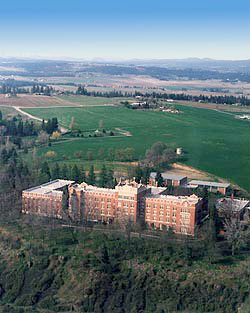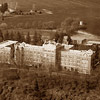History of Mount St. Michael
 Situated high on a bluff overlooking northeastern Spokane, Mount St. Michael has been a landmark in the Pacific Northwest for more than eighty years. From 1916 through the early 1980’s, it served as a training grounds for candidates for the Catholic priesthood. It remains a center of
religious education today.
Situated high on a bluff overlooking northeastern Spokane, Mount St. Michael has been a landmark in the Pacific Northwest for more than eighty years. From 1916 through the early 1980’s, it served as a training grounds for candidates for the Catholic priesthood. It remains a center of
religious education today.
Mount Saint Michael derives its name from an Indian Mission founded just
north of Spokane by a Jesuit priest, Fr. Joseph Caruana. The mission was
moved to the area of its present building in 1878 by another Jesuit, Fr.
Joseph Cataldo. The old pioneer cemetery can still be seen just off Palmer
Road. In 1881 Fr. Cataldo purchased almost 1000 acres of land at a price of
$2.00 per acre. From 1881 until 1915, St. Michael was used primarily as a
farm, supplying the Jesuit college at Gonzaga with fresh produce and dairy
products, and as a villa for weary Jesuits and students.
In the spring of 1915, work began on the hilltop of a separate scholasticate to accommodate the rising number of vocations to the Order. The cost for the project was $400,000. The Jesuit, Father Arthuis, who had just completed St. Aloysius Gonzaga Church at Gonzaga, was placed in charge of construction. He built a railroad 1100 feet in length to convey building materials up the 320-foot bluff. The four story Tudor-Gothic building was built in the shape of a “T” and contained a chapel, dining room, kitchen, gymnasium, physics and chemistry labs, lecture halls and residences for the scholastics.
In 1929 work began on the three-story west wing. The new wing housed another 100 students and contained the new library. In 1930 a seismograph from Gonzaga University was moved to a basement laboratory at the Mount, where seismologists kept careful records of seismic activity. Mount Saint Michael soon gained international acknowledgement as an important seismographic center.
In its heyday the Mount was really a self-contained city. The 700-acre farm provided all the food needed for the seminary. Jesuit brothers, farmers, tailors, bakers, cobblers, bee keepers and horticulturists, saw to the material needs of the community and the formation of the candidates placed in their charge. It was said to be one of the finest Jesuit houses of study in the world. In the wake of the Second Vatican Council, drastic drops in the number of vocations caused the Mount to close its doors as a scholasticate in 1968. For the next several years, Mount St. Michael served as a residence for priests and an ecumenical prayer and retreat center.
In 1977 developers planned to purchase this important historical and
spiritual landmark and convert the property to commercial uses. But in
December of 1977, in order to preserve this historical and spiritual part of
Spokane's heritage, a small group of traditional Catholics, through great
personal sacrifice, purchased Mount Saint Michael.
Today Mount Saint Michael continues to fulfill its mission as an educational and religious center. Maintained by the priests, Brothers and Sisters of the Congregation of Mary Immaculate Queen, it serves a variety of needs for Spokane area Catholics who value the traditional teachings and liturgy of their Faith.
The Mount’s east wing now serves as a cloister residence for the
Marian Sisters. The beautifully-adorned main chapel on the second floor is used for the solemn celebration of the sacred liturgy in the traditional Latin rite for a growing parish. The west wing houses a private academy for students from kindergarten through high school, as well as an extensive library that spills over into three auxiliary rooms, while the east wing serves as a cloistered residence for the Marian Sisters.
On the park-like grounds is a beautiful Grotto of Our Lady of Lourdes. Built in fulfillment of a vow in the 1920’s, it is a riot of color in spring as the tulips and lilacs come into bloom. Holy Mass is offered at the outdoor chapel and the faithful often gather here to pray the Rosary.
Back to top.
 Situated high on a bluff overlooking northeastern Spokane, Mount St. Michael has been a landmark in the Pacific Northwest for more than eighty years. From 1916 through the early 1980’s, it served as a training grounds for candidates for the Catholic priesthood.
Situated high on a bluff overlooking northeastern Spokane, Mount St. Michael has been a landmark in the Pacific Northwest for more than eighty years. From 1916 through the early 1980’s, it served as a training grounds for candidates for the Catholic priesthood. 